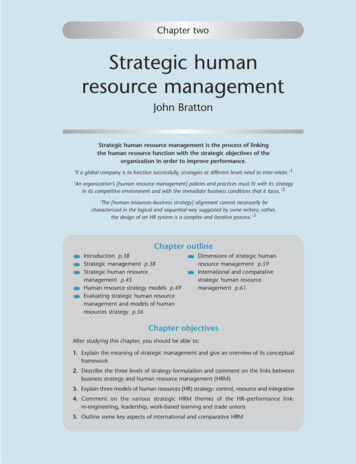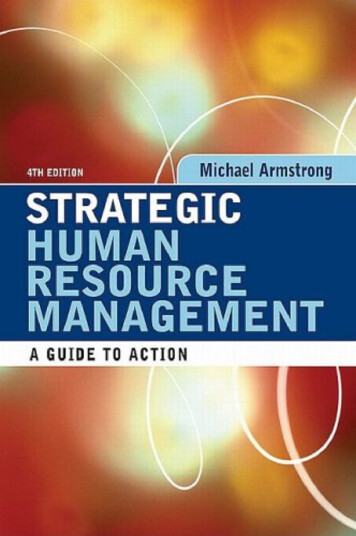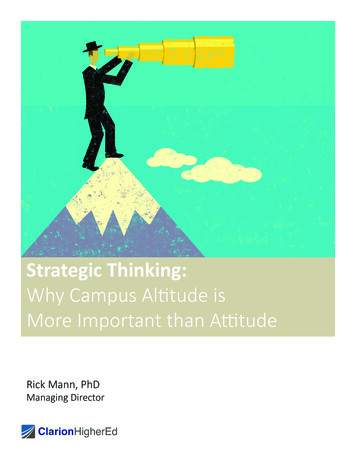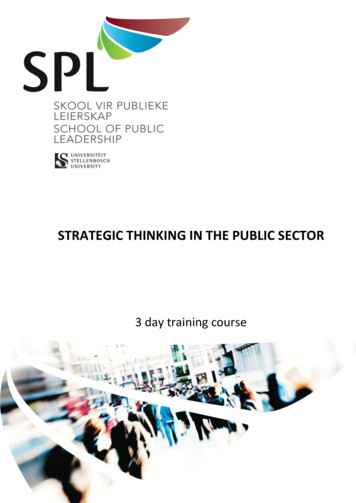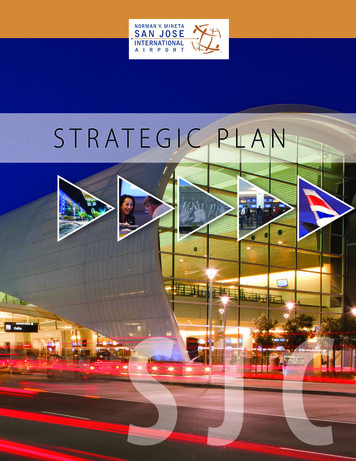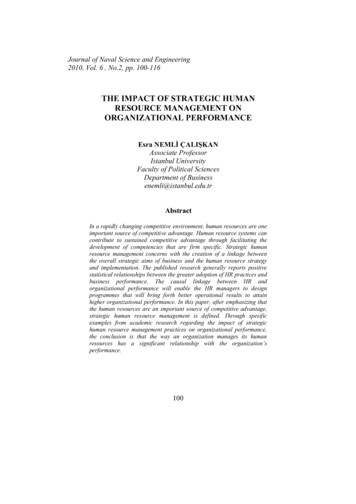
Transcription
Journal of Naval Science and Engineering2010, Vol. 6 , No.2, pp. 100-116THE IMPACT OF STRATEGIC HUMANRESOURCE MANAGEMENT ONORGANIZATIONAL PERFORMANCEEsra NEMLİ ÇALIŞKANAssociate ProfessorIstanbul UniversityFaculty of Political SciencesDepartment of Businessenemli@istanbul.edu.trAbstractIn a rapidly changing competitive environment, human resources are oneimportant source of competitive advantage. Human resource systems cancontribute to sustained competitive advantage through facilitating thedevelopment of competencies that are firm specific. Strategic humanresource management concerns with the creation of a linkage betweenthe overall strategic aims of business and the human resource strategyand implementation. The published research generally reports positivestatistical relationships between the greater adoption of HR practices andbusiness performance. The causal linkage between HR andorganizational performance will enable the HR managers to designprogrammes that will bring forth better operational results to attainhigher organizational performance. In this paper, after emphasizing thatthe human resources are an important source of competitive advantage,strategic human resource management is defined. Through spesificexamples from academic research regarding the impact of strategichuman resource management practices on organizational performance,the conclusion is that the way an organization manages its humanresources has a significant relationship with the organization’sperformance.100
Esra NEMLİ ÇALIŞKANSTRATEJİK İNSAN KAYNAKLARIYÖNETİMİNİN FİRMA PERFORMANSINAETKİSİÖzetİnsan kaynakları hızla değişen rekabet çevresinde işletmeler için önemlibir rekabet avantajı kaynağıdır. İnsan kaynakları sistemleri firmaya özelyetkinlikler geliştirmek suretiyle sürdürülebilir rekabet avantajısağlamaktadır. Stratejik insan kaynakları yönetimi firmanın stratejikamaçları ile insan kaynakları stratejisi ve uygulamaları arasında ilişkikurmaya çalışmaktadır. Firmanın insan kaynakları fonksiyonları işletmestratejisini gerçekleştirmeye yardımcı olacak şekilde düzenlenmelidir. Bukonudaki araştırmalar genellikle insan kaynakları uygulamaları ile firmaperformansı arasında pozitif bir ilişki olduğunu göstermektedir. Builişkinin varlığı insan kaynakları yönetiminin ve yöneticilerinin işletmeleriçin önemini arttırmakta, insan kaynakları ile ilgili harcamaların maliyetolarak görülmeyip yatırım olarak değerlendirilmesi gereğini ortayakoymaktadır. Bu çalışmada insan kaynaklarının işletmeler için önemli birrekavet avantajı kaynağı olduğu vurgulandıktan sonra stratejik insankaynakları yönetimi tanımlanmıştır. Akademik araştırmalardan örneklerverilerek insan kaynakları yönetimi uygulamalarının firma performansıüzerinde olumlu etkisi olduğu sonucuna varılmıştır.Keywords: Human Resources, Competitive Advantage, Strategic HumanResource Management, Organizational PerformanceAnahtar Kelimeler: İnsan Kaynakları, Rekabet Avantajı, Stratejik İnsanKaynakları Yönetimi, Şirket Performansı1.INTRODUCTIONEconomic environment is changing rapidly and this change ischaracterised by such phenomena as the globalization, changing customerand investor demands, ever-increasing product-market competition. Tocompete successfully in this environment organizations continually need toimprove their performance by reducing costs, innovating products andprocesses and improving quality, productivity and speed to market.101
The Impact Of Strategic Human Resource Management On OrganizationalPerformanceThe people who make up an organization -human resources- areconsidered to be one of the most important resources of today’s firms.People and how they are managed are becoming more important becausemany other sources of competitive success are less powerful than they usedto. Recognizing that the basis for competitive advantage has changed isessential to develop a different frame of reference for considering issues ofhuman resource management and strategy.[1] Traditional sources of successsuch as product and process technology, protected markets, economies ofscale, etc. can still provide competitive leverage but an organization’shuman resources are more vital for its sustainability.Parallel to the understanding that human resources are vital for anorganization, human resource management function is also going up inorganizational hierarchy. Human resource management aims to ensure thatthe organization obtains and retains the skilled, committed and wellmotivated workforce it needs. This means taking steps to assess and satisfyfuture people needs and to enhance and develop the inherent capacities ofpeople – their contributions, potential and employability – by providinglearning and continuous development opportunities. It involves theoperation of recruitment and selection procedures, managementdevelopment and training activities linked to the needs of the business.[2]Strategic human resource management (SHRM) represents arelatively new transformation in the field of human resource management.SHRM is concerned with the role human resource management systemsplay in firm performance, particularly focusing on the alignment of humanresources as a means of gaining competitive advantage. Organizations arebecoming aware that successful human resource policies and practices mayincrease performance in different areas such as productivity, quality andfinancial performance.102
Esra NEMLİ ÇALIŞKAN2.HUMANRESOURCESCOMPETITIVE ADVANTAGEASASOURCEOFThe concept of competitive advantage was formulated by MichaelPorter. Competitive advantage, Porter asserts, arises out of a firm creatingvalue for its customers.[3] Porter emphasized the importance ofdifferentiation, which consists of offering a product or service ‘that isperceived industry-wise as being unique’, and focus – seeing a particularbuyer group or product market ‘more effectively or efficiently thancompetitors who compete more broadly’. He then developed his wellknown framework of three generic strategies, -cost leadership,differentiation, focus- that organizations can use to gain competitiveadvantage. Porter’s widely accepted view suggests that the industry –environmental determinants- affects a firm’s performance. Resource-basedview, on the other hand, asserts that the basis for a competitive advantage ofa firm lies primarily in the application of the bundle of valuable resources atthe firm's disposal.[4] Competitive advantage, according to this view differsfrom the environmentally focused strategic management paradigm in that itsemphasis is on the links between the internal resources of the firm, itsstrategy and its performance.The resource-based view suggests that human resource systems cancontribute to sustained competitive advantage through facilitating thedevelopment of competencies that are firm specific.[5] The sustainedsuperior performance of many companies has been attributed to uniquecapabilities for managing human resources to gain competitive advantage.Conversely, to the extent that HR systems inhibit the mobilization of newcompetencies and/or destroy existing competencies, they may contribute toorganizational vulnerability and competitive disadvantage.In the closing years of the twentieth century, management has cometo accept that people, not products, markets, cash, buildings, or equipment,are the critical differentiators of a business enterprise. All the assets of anorganization, other than people, are inert. They are passive resources thatrequire human application to generate value. The key to sustaining a103
The Impact Of Strategic Human Resource Management On OrganizationalPerformanceprofitable company or a healthy economy is the productivity of theworkforce.[6]What is important to recognize is why success through humanresources can be sustained and cannot readily be imitated by competitors.The reason is that the success that comes from managing people effectivelyis often not as visible or transparent as to its source. Culture, how people aremanaged, and the effects of this on their behavior and skills are sometimesseen as the "soft" side of business, occasionally dismissed.[7] Even whenthey are not dismissed, it is often hard to comprehend the dynamics of aparticular company and how it operates because the way people aremanaged often fits together in a system. It is easy to copy one thing butmuch more difficult to copy numerous things.HRM needs to achieve the following strategic goals in order for thecompany to gain and sustain competitive advantage:[8] to invest in people through the introduction and encouragementof learning processes designed to increase capability and align skills toorganizational needs, to ensure that the organization identifies the knowledge requiredto meet its goals and satisfy its customers and takes steps to acquire amddevelop its intellectual capital, to define the behaviours required for organizational success andensure that these behaviours are encouraged, valued and rewarded, to encourage people to engage wholeheartedly in the work theydo for the organization, to gain the commitment of people to the organization’s missionand values.To achieve these goals it is necessary to understand the linkagebetween HRM and business strategy.104
Esra NEMLİ ÇALIŞKAN3.THE STRATEGIC ROLE OF HUMAN RESOURCEMANAGEMENTThe human resource management function has consistently faced abattle in justifying its position in organizations. At good times when thereare enough budgets, firms easily justify expenditures on training, staffing,rewards and employee involvement systems, but when faced with financialdifficulties, such HR systems get the earliest cutbacks.The advent of the subfield of strategic human resource management(SHRM), devoted to exploring HR’s role in supporting business strategy,provided one opportunity for demonstrating its value to the firm. The birthof the field of strategic human resource management can be dated back to1984, when Devanna, Fombrun and Tichy extensively explored the linkbetween business strategy and human resources.[9]HRM discipline has witnessed a great deal of change over the past25 years. These changes represent two major transformations. The first isthe transformation from being the field of personnel management to beingthe field of human resource management. The second is the transformationfrom being the field of human resource management to being the field ofstrategic human resource management.[10]The first transformationincorporated helped the recognition that people are an important asset inorganizations and can be managed systematically. The secondtransformation has built on the preceeding knowledge base of the discipline.This tranformation is based upon the recognition that, in addition tocoordinating human resource policies and practices with each other, theyneed to be linked with the needs of the organization. Given that these needsare reflected in the strategies of the firm, this transformation of “humanresource management” came to be known as “strategic human resourcemanagement”.Strategic human resource management is based upon the recognitionthat organizations can be more effective if their human resources aremanaged with human resource policies and practices that deliver the right105
The Impact Of Strategic Human Resource Management On OrganizationalPerformancenumber of people with the appropriate behaviours, the needed competenciesand the necessary level of motivation to the organization.To put it another way, strategic human resource management is “thecreation of linkage or integration between the overall strategic aims ofbusiness and the human resource strategy and implementation. In principle,the processes and people within the company are managed in such a way asto foster the aims of the business strategy and create an integrated approachto managing the various human resource functions, such as selection,training and reward so that they complement each other”.[11]Strategic human resource management may bring a number ofbenefits to the organization: [12] Contributing to the goal accomplishment and the survival ofthe company, Supporting and successfully implementing business strategiesof the company, Creating and maintaining a competitive advantage for thecompany, Improving the responsiveness and innovation potential of thecompany, Increasing the number of feasible strategic options available tothe company, Participating in strategic planning and influencing the strategicdirection of the company as an equally entitled member of top management, Improving cooperation between the HRM department and linemanagers.SHRM’s spreading popularity owes much to the promise of greaterorganizational effectiveness achievable, through the development ofinternally consistent bundles of human resource strategies which areproperly linked to business strategies.[13]106
Esra NEMLİ ÇALIŞKANResearchers in the field of SHRM have increasingly relied on theresource-based view of the firm to explain the role of human resourcepractices in firm performance.[14] Resource based view of strategy is thatthe strategic capability of a firm depends on its resource capability,especially its distinctive resources. Indeed, theoretical research on SHRMhas suggested that systems of HR practices may lead to higher firmperformance and be sources of sustained competitive advantage becausethese systems of practices are often unique, causally ambiguous, anddifficult to imitate.[15] HR practices can enhance firm performance whenthey are internally aligned with one another to manage employees in amanner that leads to competitive advantage.[16] HR practices can createvalue for a firm when the individual practices are aligned to develop criticalresources or TIONALMany organizations face a volatile market situation. In order tocreate and sustain competitive advantage in this type of environment,organizations must continually improve their business performance.Increasingly, organizations are recognising the potential of their humanresources as a source of sustained competitive advantage. Linked to this,more and more organisations are relying on measurement approaches, suchas workforce scorecards, in order to gain insight into how the humanresources in their organisation add value.The increasing interest in measurement is further stimulated by agrowing number of studies that show a positive relationship between humanresource management and organizational performance.[17] [18]Therelationship between HRM and firm performance has been a hotly debatedtopic over the last two decades, with the great bulk of the primary scientificresearch coming from the USA and, to a lesser extent, the UnitedKingdom.[19] Both organizations and academics are striving to prove thatHRM has a positive impact on bottom line productivity.[20] The publishedresearch generally reports positive statistical relationships between the107
The Impact Of Strategic Human Resource Management On OrganizationalPerformancegreater adoption of HR practices and business performance. [21]Sampleresearch on the link between HR and organizational performance can beseen in Table 1.In a world in which financial results are measured, a failure tomeasure human resource policy and practice implementation dooms this tosecond-class status, oversight, neglect, and potential failure.[22] Thefeedback from the measurements is essential to refine and further developimplementation ideas as well as to learn how well the practices are actuallyachieving their intended results.Arthur (1990, Data from 30 US strip mills used1992, 1994)to assess impact on labourefficiency and scrap rate byreference to the existence ofeitherahigh-commitmentstrategy or a control strategy.Firmswithahighcommitment strategy hadsignificantly higher levelsof both productivity andquality than those with acontrol strategy.Huselid (1995)Productivity is influencedby employee motivation;financial performance isinfluenced by employeeskills,motivationandorganizational structures.Analysis of the responses of 968US firms to a questionnaireexploringtheuseofhighperformance work practices,the development of synergiesbetween them and the alignmentof these practices with thecompetitive strategy.Huselidand An index of HR systems in 740Becker (1996)firms was created to indicate thedegree to which each firmadopted a high-performancework system.Becker(1997)etal Outcomes of a number ofresearch projects were analysedto assess the strategic impact onshareholdervalueofhighperformance work systems.108Firms with high values onthe index had economicallyand statistically higherlevels of performance.High-performance systemsmake an impact as long asthey are embedded in themanagement infrastructure.
Esra NEMLİ ÇALIŞKANPatterson et al The research examined the link(1997)between business performanceand organization culture and the.use of a number of HR practices.HR practices explainedsignificant variations inprofitabilityandproductivity (19% and 18%respectively). Two HRpractices were pment of employeeskills and (2) job designincludingflexibility,responsibility, variety andthe use of formal teams.Thompson(1998)A study of the impact ofhighperformance work practicessuch as teamworking, appraisal,job rotation, broad-banded gradestructures and sharing ofbusiness information in 623 UKaerospace establishments.Thenumber ofHRpractices and the proportionof the workforce coveredappeared to be the keydifferentiatingfactorsbetween more and lesssuccessful firms.The1998WorkplaceEmployeeRelationsSurveyAn analysis of the survey, whichsampled some 2,000 workplacesand obtained the views of about28,000 employees.A strong association existsbetween HRM and bothemployee attitudes andworkplace performance.The Future ofWork Survey,Guest et al(2000).835 private sector organizationswere surveyed and interviewswere carried out with 610 HRprofessionals and 462 chiefexecutives.A greater use of HRpractices is associated withhigher levels of employeecommitmentandcontribution and is in turnlinked to higher levels ofproductivity and quality ofservices.109
The Impact Of Strategic Human Resource Management On OrganizationalPerformancePurcell(2003)etal AUniversityofBathlongitudinal study of 12companies to establish howpeople management impacts onorganizational performance.Themostsuccessfulcompanies had what theresearchers called ‘the bigidea’. The companies had aclear vision and a set ofintegrated values whichwere embedded, enduring,collective, measured andmanaged. Clear evidenceexisted between positiveattitudestowardsHRpolicies andpractices,levelsofsatisfaction,motivation andcommitment,andoperational performance.Table 1. Outcomes Of Research On The Link Between HR And OrganizationalPerformanceSource: Michael Armstrong (2006). Strategic Human Resource Management : A Guide toAction. Kogan Page. London. p. 73-74.The assumption underpinning the practice of HRM is that people arethe organization’s key resource and organizational performance largelydepends on them. If, therefore, an appropriate range of HR policies andprocesses is developed and implemented effectively, then HR will make asubstantial impact on firm performance. Much of the research over the lasttwo decades has attempted to answer two basic questions: ‘Do HR practicesmake a positive impact on organizational performance?’; ‘If so, how is theimpact achieved?’ The second question is the more important one. It is notenough to justify HRM by proving that it is a good thing. What counts iswhat can be done to ensure that it is a good thing.Guest et al.modelled the relationship between HRM andperformance as shown in Figure 1. Although there are various stakeholdersin an organization, the chief strategic goal of any business is higher financialperformance or maximization of wealth for the shareholders.[23] Financial110
Esra NEMLİ ÇALIŞKANperformance of an organization depends to a large extent on effectiveoperational performance. The operational performance of an organization isa function of people, process and technology. For effective interaction ofpeople with technology and process, the people in the organization have tobe competent enough, with the required knowledge, skill and abilities.Competence of the individual is an important factor that decides operationaleffectiveness in terms of providing quality products and services within ashort time. HRM practices such as selection, training, work environmentand performance appraisal may enhance the competence of employees forhigher performance.HReffectivenessBusinessStrategyHR PracticesHR ality ofgoods StrategyFigure 1. The Relationship Between HRM and PerformanceSource: Michael Armstrong (2006). Strategic Human Resource Management: A Guide toAction. Kogan Page. London. p. 75.Obviously, human resources rarely has a direct effect on firmperformance. This is particularly true when the business logic of HR’s effectrequires that human resources drive firm performance through itscontribution to effective strategy execution. HR professionals (and linemanagers) need to recognize that effective strategy execution is the basis ofshareholder value and that effective strategy execution is a system ofintermediate outcomes. Thinking like a strategy manager means recognizingthe importance of the causal relationships between HR decisions and theseintermediate outcomes that ultimately drive strategic success in111
The Impact Of Strategic Human Resource Management On OrganizationalPerformanceorganizations.[24] The practice areas covered by HR strategies that impacton performance are summarized in Table 2.HR practice areaAttracting, developing andretaininghigh-qualitypeopleHow it impactsMatches people to the strategic and operationalneeds of the organization. Provides for theacquisition, development and retention of talentedemployees who can deliver superior performance,productivity, flexibility, innovation and high levelsof personal customer service and who ‘fit’ theculture and the strategic requirements of theorganization.Talent managementWins ‘war for talent’ by ensuring that the talentedand well-motivated people required by theorganization to meet present and future needs areavailable.Working environment – Develops ‘the big idea’, ie a clear vision and a setcore values, leadership, of integrated values. Makes the organization ‘awork–lifebalance, great place to work’.managing diversity, secureemploymentJob and work designProvides individuals with stimulating andinteresting work and gives them the autonomy andflexibility to perform their jobs well. Enhances jobsatisfaction and flexibility, which encourages highperformance and productivityLearning and developmentEnlarges the skill base and develops the levels ofcompetence required in the workforce. Encouragesdiscretionary learning, which happens whenindividuals actively seek to acquire the knowledgeand skills that promote the organization’sobjectives. Develops a climate of learning – agrowth medium in which self-managed learning aswell as coaching, mentoring and training flourish.112
Esra NEMLİ ÇALIŞKANHR practice areaHow it impactsManaging knowledge and Focuses on both organizational and individualintellectual capitallearning and on providing learning opportunitiesand opportunities to share knowledge in asystematic way. Ensures that vital stocks ofknowledge are retained and deals with improvingthe flow of knowledge, information and learningwithin the organization.Increasingmotivation, Encourages people to identify themselves with andcommitmentandrole act upon the core values of the organization andengagementwillingly to contribute to the achievement oforganizational goals. Develops a climate ofcooperation and trust, clarifying the psychologicalcontract.High-performanceDevelops a performance culture that encouragesmanagementhigh performance in such areas as productivity,quality, levels of customer service, growth, profitsand, ultimately, the delivery of increasedshareholder value. Empowers employees to exhibitthe discretionary behaviours most closelyassociated with higher business performance suchas risk taking, innovation, knowledge sharing andestablishing trust between managers andsubordinates.Reward ent and discretionary behaviour byvaluing and rewarding people in accordance withtheir contribution.Table 2. How HR Impacts Organizational PerformanceSource: Michael Armstrong (2006). Strategic Human Resource Management: A Guide toAction. Kogan Page. London. p. 77-78.5.CONCLUSIONSince it is clearly understood from academic research that humanresources are a source of sustained competitive advantage, while,traditionally, the costs associated with the development of HR strategy have113
The Impact Of Strategic Human Resource Management On OrganizationalPerformancebeen regarded as an operating expense, these costs would be betterconsidered as an investment in capital assets.The way an organization manages its HR has a significantrelationship with the organization’s results, a revelation that supports theresource-based view, where business competitiveness is related, at least inpart, to the investments in company specific assets. Although the publishedresearch generally reports positive statistical relationships between thegreater adoption of HR practices and business performance, it should alsobe kept in mind that many other factors besides HR practices couldinfluence organizational performance. Also, it is possible that there arecomplex relationships between HR practices and other resources of the firm.The causal linkage between HR and organizational performance willenable the HR managers to design programmes that will bring forth betteroperational results to attain higher organizational performance. The focus ofthe HR management should be to understand organizational performanceprocesses and design HR practices that influence process and outcomevariables.REFERENCES[1] Pfeffer, Jeffrey, (1994). Competitive Advantage Through People: Unleashing ThePower of Workforce, Harvard Business School, USA, p.6.[2] Armstrong, Michael, (2008). Strategic Human Resource Management: A Guide toAction, 4th Edition, Kogan Page, London, p.11.[3] Porter, Michael E., (1985). Competitive Advantage, Creating and Sustaining SuperiorPerformance, The Free Press, USA, p.38.[4] Wernerfelt, Birger, (1984). “A Resource-based View of the Firm”, StrategicManagement Journal, Vol.5, p.172, pp.171-180.[5] Lado, Augustine A., Wilson, Mary C., (1994). “Human Resource Systems AndSustained Competitive Advantage: A Competency-Based Perspective”, Academy ofManagement Review, Vol. 19. No. 4, p.699, pp.699-727.[6] Fitz-enz, Jac, (2000). The ROI of Human Capital: Measuring the Economic Value ofEmployee Performance, American Management Association, USA, p.1.[7] Pfeffer, Jeffrey, (1994). Competitive Advantage Through People: Unleashing ThePower of Workforce, Harvard Business School, USA, p.57.114
Esra NEMLİ ÇALIŞKAN[8] Armstrong, Michael, Baron, Angela, (2003). Strategic HRM: The Key To ImprovedBusiness Performance, CIPD, London, p.xviii.[9] Wright, Patrick M., Dunford, Benjamin B., Snell, Scott A., (2007). “Human Resourcesand Resource-Based View of The Firm”, in: Randall S. Schuler, Susan E. Jackson,Strategic Human Resource Management, 2nd Edition, Blackwell, USA, p.76.[10] Schuler, Randall S., Jackson, Susan E., (2007). Strategic Human ResourceManagement, Blackwell Publishing, USA, , p.xiii.[11] Gratton, Lynda et al., (1999). Strategic Human Resource Management, OxfordUniversity Press, New York, p.7.[12] Brewster, Chris et al., (2000). Contemporary Issues in Human Resource Management :Gaining a Competitive Advantage, Oxford University Press, Cape Town, p. 56.[13] Dyer, Lee, Reeves, Todd.(1995). “Human Resource Strategies and Firm Performance:What Do We Know and Where Do We Need To Go?”, The International Journal of HumanResource Management 6:3, p.657, pp.656-670.[14] Collins, Christopher J., Clark, Kevin D., (2003). “Strategic Human Resource Practices,Top Management Team Social Networks, And Firm Performance: The Role Of HumanResource Practices In Creating Organizational Competitive Advantage”, Academy ofManagement Journal, Vol. 46, No. 6, p.740, pp.740–751.[15] Lado, Augustine A., Wilson, Mary C., 1994. “Human Resource Systems AndSustained Competitive Advantage: A Competency-Based Perspective”, Academy ofManagement Review, Vol. 19. No. 4, p.702, pp.699-727.[16] Delery, John E., Doty, D.Harold. (1996). “Modes of Theorizing in Strategic HumanResource Management: Tests of Universalistic, Contingency and ConfigurationalPerformance Predictions”, Academy of Management Journal, Vol 39, No.4, p.803, pp.802835.[17] Voorde, Van De, Paauwe K. J., Van Veldhoven, M., (2010). “Predicting Business UnitPerformance Using Employee Surveys: Monitoring HRM-Related Changes”, HumanResource Management Journal, 20: 1, p.44, pp. 44–63.[18] Cappelli, Peter, Crocker-Hefter, Anne, (1996) “Distinctive Human Resources areFirms’ Core Competencies”, in: Randall S. Schuler, Susan E. Jackson, Strategic HumanResource Management, 2nd Edition, Blackwell, USA, 2007, p.191.[19] Boselie, Paul, Paauwe, Jaap, Jansen, Paul, (2000). Human Resource Management andPerformance: Lessons from the Netherlands, Erasmus Research Institute Of Management,Rotterdam, p.2.[20] D'Annunzio-Green, Norma (Editor); Maxwell, Gillian (Editor); Watson, Sandra(Editor), (2002). The Impact of Strategic Human Resource Management on OrganizationalPerformance, Emerald Group Publishing, Bradford, GBR, p. 205.[21] Richardson, Ray, Thompson, Marc, (1999). The Impact of People ManagementPractices on Business Performance: A Literature Review, Institute of Personnel AndDevelopment, Great Britain, p.xi.[22] Pfeffer, Jeffrey, (1994). Competitive Advantage Throu
strategic human resource management is defined. Through spesific examples from academic research regarding the impact of strategic human resource management practices on organizational performance, the conclusion is that the way an organization manages its human resources has a significant relationship with the organization's .




